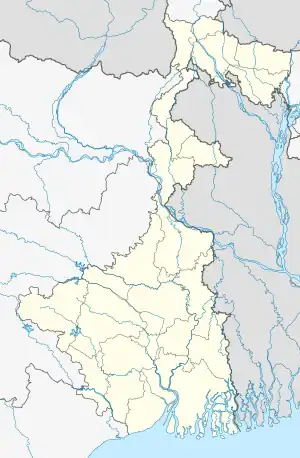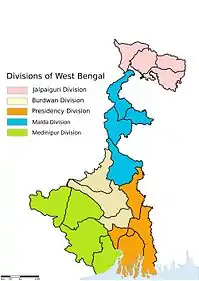Nabarun | |
|---|---|
Neighbourhood | |
 Nabarun Location in West Bengal, India  Nabarun Nabarun (India) | |
| Coordinates: 24°46′36″N 87°54′37″E / 24.776556°N 87.91036°E | |
| Country | |
| State | West Bengal |
| District | Murshidabad |
| Languages | |
| • Official | Bengali, English |
| Time zone | UTC+5:30 (IST) |
| PIN | 742181 (Nabarun) |
| Lok Sabha constituency | Maldaha Dakshin |
| Vidhan Sabha constituency | Farakka |
| Website | murshidabad |
Nabarun is a neighbourhood of Farakka, not identified in 2011 census, with a post office, in Farakka CD Block in Jangipur subdivision of Murshidabad district in the state of West Bengal, India.
Geography
M: municipal town, CT: census town, R: rural/ urban centre, F: Facility
Abbreviation- TPS: Thermal Power Station
Owing to space constraints in the small map, the actual locations in a larger map may vary slightly
Location
Nabarun is located at 24°46′36″N 87°54′37″E / 24.776556°N 87.91036°E.
Area overview
Jangipur subdivision is crowded with 52 census towns and as such it had to be presented in two location maps. One of the maps can be seen alongside. The subdivision is located in the Rarh region that is spread over from adjoining Santhal Pargana division of Jharkhand. The land is slightly higher in altitude than the surrounding plains and is gently undulating.[1][2] The river Ganges, along with its distributaries, is prominent in both the maps. At the head of the subdivision is the 2,245 m long Farakka Barrage, one of the largest projects of its kind in the country.[3] Murshidabad district shares with Bangladesh a porous international border which is notoriously crime prone (partly shown in this map).[4] The subdivision has two large power plants - the 2,100 MW Farakka Super Thermal Power Station and the 1,600 MW Sagardighi Thermal Power Station.[5][6] According to a 2016 report, there are around 1,000,000 (1 million/ ten lakh) workers engaged in the beedi industry in Jangipur subdivision. 90% are home-based and 70% of the home-based workers are women.[7][8][9] As of 2013, an estimated 2.4 million people reside along the banks of the Ganges alone in Murshidabad district. Severe erosion occurs along the banks.[10]
Note: The two maps present some of the notable locations in the subdivision. All places marked in the maps are linked in the larger full screen maps.
Economy
The 2,100 MW Farakka Super Thermal Power Station of NTPC at Nabarun was commissioned between 1986 and 2011.[11]
Transport
Education
Delhi Public School NTPC is located at Nabarun.[13]
See also
References
- ↑ "District Census Handbook: Murshidabad, Series 20 Part XII A" (PDF). Physiography, Page 13. Directorate of Census Operations, West Bengal, 2011. Retrieved 24 July 2017.
- ↑ "Murshidabad". Geography. Murshidabad district authorities. Retrieved 24 July 2017.
- ↑ "Farakka Barrage Project". FBP. Retrieved 12 September 2017.
- ↑ "Child labour, illness & lost childhoods, India's tobacco industry". Edge of Humanity Magazine, 27 December 2020. Retrieved 13 July 2021.
- ↑ "Power Generation". Farakka. NTPC. Retrieved 7 August 2016.
- ↑ "The West Bengal Power Development Corporation Limited". Sagardighi Thermal Power Project. WBPDCL. Retrieved 15 August 2017.
- ↑ Kar, Sunirmal. "Child workers in household industry: a study of beedi industry in Murshidabad district of West Bengal" (PDF). Viswa Bharati University thesis, page 5. Shodhganga. Retrieved 28 August 2017.
- ↑ "The 'Poor man's cigarette'". Gurvinder Singh. The Statesman, 22 January 2017. Retrieved 28 August 2017.
- ↑ "Beedi workers of Jangipur hold key". Indrani Dutta. The Hindu, 1 May 2009. Retrieved 28 August 2017.
- ↑ "Types and sources of floods in Murshidabad, West Bengal" (PDF). Swati Mollah. Indian Journal of Applied Research, February 2013. Archived from the original (PDF) on 20 August 2017. Retrieved 5 September 2017.
- ↑ "Power Generation". Farakka. NTPC. Retrieved 27 August 2016.
- ↑ "Rationalisation of Numbering Systems of National Highways" (PDF). New Delhi: Department of Road Transport and Highways. Archived from the original (PDF) on 1 February 2016. Retrieved 10 February 2017.
- ↑ "Delhi Public School". Time2Study.in. Retrieved 30 May 2017.
